 |
 |
 |
 |
 |
 |
 |
 |
 |
The following text is the abridged version of the book by Edward Kopówka “The extermination of the Siedlce Jews”, to be published in 2005
 |
| Ghettos |
 |
| Ghetto Map |
From the beginning of the occupation, the Germans turned their entire propaganda machinery on Polish society in order to justify their murdering of Jews. For this purpose they made use of posters with texts such as "Typhus, spotted fever, is one of the most dangerous of diseases, often fatal. Typhus is very contagious and therefore it can spread quickly and easily into serious epidemics. In the Generalgouvernement it is widespread, particularly amongst the Jews." On
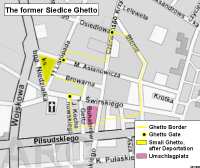 |
| The former Ghetto |
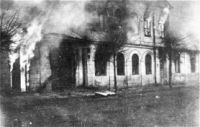 |
| The burning Siedlce Synagogue * |
There were 25 Judenrat members in all. "The members of the Jewish Council were, in general, recognized Jewish leaders, to whom the Nazis gave enormous power until the moment when they, too, were deported." The Council managed Jewish property and manpower, and drew up "transport lists" (lists of persons destined for extermination camps). A Jewish police force kept order, wearing as insignia caps of office, nightsticks, and special armbands with the inscription "Jüdischer Ordnungsdienst". There were around 50 of them. Gewisser stood at their head. There was also the Sanitätsdienst – the Sanitation Service. Its purpose was to maintain cleanliness in the apartments, courtyards, and streets of the Jewish quarters. After the closed ghetto was instituted, the functionaries of the Sanitation Service became part of the Health Division of the Jewish Council. In addition to their previous duties, its members were ordered to assign living quarters for Jews who moved to the already overcrowded ghetto. The Judenrat also had an employment office (Arbeitsamt), whose director was Izrael Friedman.
The chairman of the Siedlce Judenrat was a man of already advanced age: Weintraub who was a worthy local social and political activist. For many years he had been at the head of the Zionist movement and the religious community. He kept a diary in which he recorded the important events of the town, as well as stories, told to him by Jewish elders. Unfortunately nearly all these writings have been destroyed. What has been saved is only that which he had published in the press in the interwar period. The function of chairman of the Judenrat was filled not by Weintraub, but by Dr Henryk Loebel. Emil Karpinski remembers that "people fought each other, literally fought, gave bribes, and used every possible means to get a position in the Judenrat or the Jewish police."
By December 1939, the Judenrat was already ordered to make a "contribution" of 20,000 zlotys. In 1940, from spring to winter, the Siedlce Jews were used for land reclamation work on the Liwiec River. Workers, divided into 15 person groups, worked under Polish direction. The Germans had overall supervision of the labour, and the workers were supervised by SS-men, who controlled the progress of the work. Around 1,500 Jews left the ghetto every day and went to the jobs to which they had been assigned.
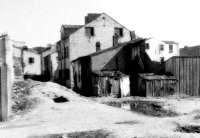 |
| Ghetto Houses |
Quarter II included the following streets: Sienkiewicza, Kilinskiego, Przejazd (now the extension of J. Kilinskiego), Asza, Kozia (no longer in existence), Poprzeczna (now Esperanto), Pulaskiego, and Przechodnia (now an extension of J. Kilinskiego). It counted 3,306 Jews and 372 non-Jews, together 3,678 persons. Together, according to the register, Quarters I and II were inhabited by 6,895 Jews. Quarters I and II formed the so-called "open ghetto".
In November 1940, the Judenrat received a new order for a "contribution" of 100,000 zlotys. In December 1940 the number of Jews living in the town amounted to 13,000. During 1940, Jews from the Warthegau were forced to move to Siedlce, and from that year many Jews had to work in forced labour camps within the city.
At the end of December 1940, the occupation authorities issued a decree requiring Jews to wear armbands with the Star of David and the inscription Jude. It was also decreed that Jewish shops must be marked.
The Germans were also determined not to allow Jews, under the pressure of the existing situation, to change their faith. On 21 February 1941, the administrator of the Siedlce diocese, Bishop Czeslaw Sokolowski, issued a ruling to the Catholic clergy, in which he suspended permission for the baptism of Jews, Muslims, or pagans. He did so under pressure from the authorities of the Generalgouvernement, and in a decree of 23 January 1941, in order to prevent the numerous conversions from Judaism to Catholicism, the Germans decided that it would be the competent starosta or mayor who would make the decision. The Bishop’s ruling, however, was not too carefully observed, as the Generalgouvernement authorities addressed themselves again to the Diocesal Curia in Siedlce in this matter. In a document of 10 October 1942 they required that "adults be checked at baptism, to find out if they are of Aryan descent."
 |
| In the Ghetto, May 1941 |
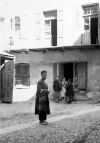 |
| Ghetto |
"At the beginning of the occupation people behaved with compassion towards one another, but with the growth of terror, poverty, and all the "plagues of Egypt", peoples’ hearts became desensitized and even vicious; for a piece of bread or the shadow of hope of saving themselves many served the Germans or persecuted others in various ways. Among others, these included a fairly large number of the Jewish police as well as Judenrat functionaries."
For a certain time contact remained between craftsmen in the ghetto – mainly shoemakers – and their business partners on the "Aryan" side. The latter placed orders with the craftsmen, and provided food in payment. The transfer point was a stretch of Sadowa Street. On receiving word of this from an informant, the Germans sealed off the ghetto. In November, Jews from the following localities were moved to Siedlce: Czuryly, Domanice, Krzeslin, Niwiski, Skorzec, Skupie, Stara Wies, Wisniew, Wodynie, Zbuczyn, Suchozebry, and Zeliszew. In March 1942, 12,417 Jews lived within the ghetto precincts.
In the winter of 1941/42 a typhus epidemic broke out. It was the result of the terrible conditions prevailing in the ghetto. A large number of people were crowded into a not very large area and the sanitary conditions worsened as the streets of the ghetto did not possess sewers. As Mojzesz Halbersztadt remembers:
"15 people lived in rooms of 10 sq. metres... There wasn’t room for everyone, people slept outside, in the corridors... Gestapo functionaries who came into the ghetto asked us ironically if we were receiving letters from our relatives in Russia on the Ladoga River, because at first we did not know where they were transporting the Jewish population."
All contacts between the Polish and Jewish populations were cut off, which resulted in a sudden worsening of provisioning. The only item that could be acquired without difficulty was the Jewish Gazette, published in Krakow, and intended for Jewish readers. It praised the work camps for Jews, which were to be found outside the ghetto boundaries.
In December 1941, the occupiers required the Judenrat to provide them with all the furs in the possession of Jews. Persecution continued all the time. 1942 was greeted with great apprehension. The local cabalists feared it because the year contained the same numerals as the year 1492, the year in which the Jews were driven out of Spain. On 3 March 1942, the Germans seized 10 Jews and shot them at Stok Lacki under the pretext that they had refused to work. Under German pressure, the Judenrat issued a declaration supporting the sentence. In June 1942, Nazis required the Jewish Council to provide a certain number of craftsmen and their machines. At the beginning, the place to which they had been sent was kept secret. Later it turned out that it was the camp at Majdanek.
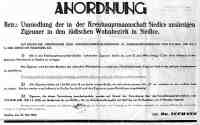 |
| Gypsy Resettlement Order * |
For the most part, the Jewish population passively accepted the future in store for them. Only a small number tried to flee or to fight. In the winter of 1942, there was an attempt to form an underground organization by the name of "Polish Socialists". The braver people tried to escape in trains carrying wounded Italian soldiers, which stopped at the railway station in Siedlce.
Hercel Kave, together with Liwerant and Nelkienbojm, successfully made such an attempt in 1942. They arrived in Italy, survived the war, and emigrated to Israel.
Self-defence groups began to form on the basis of acquaintance, or of school, social, family, or political contacts, both within the ghetto and without. In the middle of 1940, the Polish Armed Organisation, whose composition included members of PSL (Polish Peoples Party, called ludowcy) issued a statement in which it was written, amongst other things, that "Wherever necessary, in as far as possible help should be given to members of the Jewish nation. The form of help should be dictated by needs on the one hand, and by possibilities on the other, with the aim of making it possible to survive the common danger and common enslavement. Let us remember that after the destruction of the Jewish people, the unpredictable occupiers will commence the complete liquidation of Poles."
In November 1942, a group of Siedlce Jews, who had previously worked on the Drupie estate in the district of Skorzec, formed a 30 person armed unit. It operated in the forested areas known as the Jata. This group maintained loose contacts with other partisan units operating in the area. Six persons of this group survived till the end of the war.
The penalty for leaving the ghetto without permission was death. The person seized was searched and then shot in a clever fashion: "Usually, between ten and eleven in the evening, the condemned person was taken outside the gates of the ghetto on 11 Listopada St. or Targowa Street. The person would be ordered to run towards the ghetto gate and would be shot in the back. Every day in the evening the inhabitants of neighbouring houses heard shots. The next day the Jewish police collected the bodies of those killed."
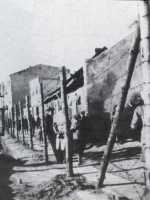 |
| Ghetto Fence |
Unfortunately there were also some bad examples: It happened sometimes that the Polish population turned in Jews who had left the ghetto or work camps in search of food. Most often they were turned over to the Polish blue police or the German gendarmes. Those who were caught were most often killed. There were also cases of Polish bandits murdering Jews. Such an incident occurred in Opole Nowe near Siedlce, where in March 1944 over a dozen hiding Jews were killed. These included Dr Loebel’s son Witold, Roman Głazowski, Lolka Zalcman, Herszko Cygielstein, Leibko Wiśnia, and Romińska. In the village of Trzciniec in 1943 peasants murdered Szmul and Gieńka Krawiec. They were afraid that if the Krawiecs were arrested, they would provide the names of the householders who had helped them, as had happened in the neighbouring village of Jagodne, where a Jew who had been arrested indicated 28 householders who had helped him. They were arrested by the Germans.
In July 1942, the governor of the Warsaw District, Ludwig Fischer, conducted an inspection in Siedlce and met with a representative of the Jewish community in front of the main gate to the ghetto. In his speech his expressed his satisfaction that the Jewish population were effectively contributing towards an increase in the German war effort. He also spoke of opening workshops in which the Jews would find employment. This meeting gave great comfort to the Jews.
It was a false hope. Fischer deliberately wanted to calm the Siedlce Jewish community. The Aktion Reinhard, whose goal was the final liquidation of the Jews, was already underway. Information about the liquidation of ghettos in other cities and about the transfer of people to the area of Malkinia had already reached the ghetto.
On 20 August 1942, the inhabitants of the ghetto received a serious warning. The Germans demanded the immediate provision of several dozen workers for the purpose of unloading railway cars. After the cars were opened it was discovered that inside were the bodies of Jewish men, women, and children, who had come from Radom. The railway car was part of a "death train" that transported Jews to Treblinka. As a result of a fire the car could not reach its destination. When the workers opened the car they saw around 100 dead bodies – squeezed together and intertwined one with the other. They had all died from lack of air, from the heat, and from the fumes of the quicklime with which the floor of the car was strewn. "Under the rifle butts of the SS-men, the workers had to empty the car. The dead were taken to the Jewish cemetery, where they were buried. The Germans spread the news that the dead were prisoners being moved to another jail, but no one believed it."
The Siedlce Jews saw with their own eyes that deportations were taking place. People wondered - to where? Everyone wanted to believe that it was to somewhere in the east, maybe Smolensk. The name of Treblinka was also mentioned. In the ghetto an atmosphere of uncertainty prevailed.
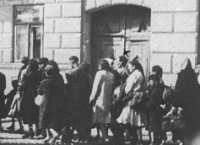 |
| Deportation #1 * |
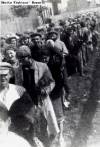 |
| Deportation #2 * |
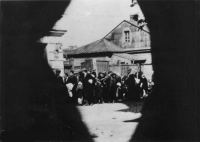 |
| Deportation on Florianska Street * |
Some, particularly those discovered by the Ukrainians, were killed on the spot. The others were led to the Umschlagplatz. The events of this day and following days were described by Cypora Jablon-Zonszajn (see Siedlce Memoirs):
 |
| Umschlagplatz * |
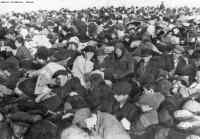 |
| Umschlagplatz - Thirsty Jews * |
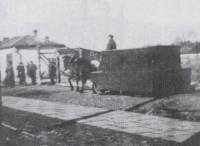 |
| Funeral Procession |
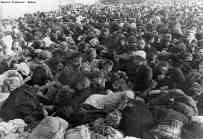 |
| Umschlagplatz - Waiting for Hours * |
The history teacher Wasercug was shot on the square, since he spoke to the crowd and asked them to retain their dignity in this last hour. As he was shot he shouted to the Germans, "Your hour will come, vile reptiles!"
During all of this time, the Germans were shooting Jews at the Jewish cemetery on Szkolna Street. One of the eye witnesses remembers these days thus:
"When we went into the courtyard of the prison I saw there a group of Jews – men. They were well dressed, they were even wearing furs ... A Gestapo agent informed the Jews, gathered in the courtyard, that they were going to the east, that they would work there, and that they were in no danger. Then the Jews were ordered to get into a vehicle driven by Domanski (...). A Gestapo man got into the cabin. I stood on the running board of the car. We went to the Jewish cemetery. There I saw many newly-dug trenches and the bodies of very many persons of Jewish origin. There were the bodies of men, women, and children. The group of Jews that we had brought to the cemetery was made to stand in three lines, in such a manner that the first row stood by the wall, the second kneeled, and the third half lay, half sat. It gave the impression that the group had been placed for a photograph. These Jews were shot with machine guns by three Gestapo men and four functionaries of the Sonderdienst (...). Later, these same Gestapo agents and the Sonderdienst functionaries finished off those Jews who lay on the ground with pistol shots (...). From the prison we brought a group of thirty-some women of Jewish origin. All the Jewish women brought to the Jewish cemetery were shot against the cemetery wall by these same culprits. In contrast to the men, while they were being shot the women shouted, cried, and even tried to resist."
At this cemetery, those inhabitants of the town whom the Nazis themselves recognized as Jews were also shot. Marcin Hora, head of the fire department, wrote:
"I personally saw how, at the local cemetery, in August 1941 (in fact, 1942) 180 persons who were brought there in three trucks were shot. They were both men and women. Apparently they were accused of being third generation Jews. Among them were the wives of former high civil servants or Polish army officers. Almost all those shot had a prayer book or other object of the Roman Catholic religion with him/her at the time."
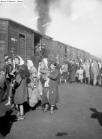 |
| Ramp #1 * |
 |
| Ramp #2 * |
 |
| Cleaning the Ramp * |
“From time to time we can hear shooting, and when we get out to see what was going on, I saw, a little distance from our track, a loading platform with a huge crowd of people… all of them were squatting or lying on the ground and whenever anyone tried to get up, the guards began to shoot… Early next morning… we become witnesses of the most ghastly scenes. The corpses of those killed the night before were thrown by Jewish auxiliary police on to a lorry that came and went four times. The guards… cram 180 people into each car, parents into one, children into another… They scream at them, shoot and hit them so viciously that some of their rifle-butts break.”
Noach Lasman describes the moment of loading thus:
"Somebody began to shout "Wasser, Wasser!’ (water, water!). Everyone took up this cry. They took it up in other cars as well and several thousand people chanted "Wasser, Wasser!" Suddenly the sound of machine gun fire could be heard from a car. The soldiers had decided to quiet the people. They placed one of the tormentors on the ramp, who put the barrel of his gun into the window of the car and blindly shot into the crowd. The shrieks of pain and the death cries of the badly wounded replaced the word "Wasser"."
Pfoch’s account continues:
“ When at last our train leaves the station, at least fifty dead, women, men and children, some of them totally naked. lie along the track… Eventually our train followed the other train and we continued to see corpses on both sides of the track – children and others… When we reach Treblinka station the train is next to us again – there is such an awful smell of decomposing corpses in the station, some of us vomit. The begging for water intensifies, the indiscriminate shooting by the guards continues….”
The entire time the search continued for those in hiding. On 24 August 1942 the staff and patients of the Jewish hospital on 1 Maja Street (now the Emergency Care building on Swirskiego Street), around 100 people in all, were killed. All the patients were shot in their beds; over a dozen new-born children were also murdered. The hospital staff – the doctors, nurses, and orderlies – were shot in the hospital courtyard. Dr Loebel was killed with this group. Miraculously, R. Landau escaped, extricating herself from under the pile of bodies after the massacre and the departure of the Germans.
Two days later, on 26 August 1942, 29 women who had previously worked at sorting the clothes of the victims were shot at the cemetery. Estera Spektor managed to escape from their temporary prison on the night before the execution.
After the liquidation of the ghetto, on 27 August 1942, the Nazis made the following announcement: "As a result of the deportation of the Jews, there are empty apartments and job openings in the towns of Siedlce, Losice, and Mordy. Hard working and ambitious people, particularly artisans, now have the opportunity to set themselves up for life in the above mentioned towns."
The liquidation of the Siedlce Ghetto was appended to the report of the United Underground Organizations of the Warsaw Ghetto to the Polish government-in-exile in London, and the Allied governments on 15 November 1942. The report was transmitted to the Polish government-in-exile by the courier Jan Karski.
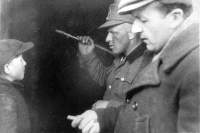 |
| Boy, interrogated * |
During the "cleansing" process around 200 people were discovered and murdered, including Przezdziecki and Goldblat. The corpses were collected by groups of Jews, who themselves pulled a two wheeled cart they called an "arba". They pulled it to the gates of the ghetto and loaded the corpses onto a wagon pulled by horses and driven by Poles. It was they who transported the corpses to the Jewish cemetery.
From the people previously chosen to survive, numbering around 600 persons, the so-called "little ghetto", called Drojek, was formed. It was located in the triangle formed by the streets Sokolowska, Aslanowicza, and 11 Listopada. These people were used for "clean up" work after the liquidation of the ghetto. In the following days, after being assured of personal safety by the German authorities, around 1,500 Jews appeared who had survived the liquidation in hiding. A new Judenrat was formed, with Hersz Ajzenberg at its head, and two members: Mosze Rotbajn (director of the employment office) and Anatol Goldberg (provisions director). A health clinic was opened, headed by Balfor, the sole Jewish doctor to have survived. A police force was also established, which took care of individual houses and acted as guards and maintainers of order. Its commanding officer was Rubinstein, and after him, Abraham Gessler.
"As a lure, the Germans left the little ghetto alone, and people, seeing that there were no more mass killings, began to be attracted, swayed by the rumours that the worst was over and that somehow survival is possible. Life goes on and within the grounds of the little ghetto stands began to open with articles of food and junk for sale. This trade went on through the wires. For rags, shoes, vessels, and Lord knows what else, one received bread, potatoes, and, in general, something to eat."
The number of those squashed into the little ghetto is estimated at between 1,500 and 3,000 persons. These were not only the Jews of Siedlce, but also escapees from other small towns who had been wandering in the Siedlce environs as well as Gypsies. Conditions in the ghetto were terrible; there was a constant insufficiency of water. Some of those who were settled in the ghetto collected the remnants of people’s property, which were sorted. The better things were sent to Germany for the use of those affected by bombing raids, the remainder were sold to the Polish population.
The functioning of the "Jewish residential quarter" in Siedlce was confirmed by a ruling of 28 October 1942 of the leader of the SS and the police in the Generalgouvernement, Krüger.
A witness:
"We are sitting in horrible conditions in a dirty, lice-infested quarter, full of Gypsies, who have become our heirs, in a quarter where death hangs in the air. The mood is almost constantly one of panic. Every day new people arrive, escapees from railroad cars coming from other towns: Lukow, Wegrow, Miedzyrzec, Kaluszyn, Sokolow and many, many others. Every day we hear that here the liquidation action was repeated a second time, there for a third time! Why haven’t they touched us yet? This time, however, we do not delude ourselves. We know that it will not pass us by."
Both Jews and Poles understood the hopelessness of the situation. Many years later, Czesław Ulko, characterizing that time, said:
"I went to work after eating lunch. I saw a Jew with whom I was acquainted, the son of a shop-owner, Jankiel Zylbersztein from Kazimierzowska Street, who was sweeping the street by the district office. I said to him 'Jankiel, run away because they will kill you.' Then he said: 'Fine, but where to?' It was only later that I realized how apt his reply had been."
The first order the German authorities directed to the new Judenrat was to pay the fire department for pouring water on people during the deportation. There was a guard detachment composed of two Jewish policemen and a Polish blue policeman at the gate of the little ghetto. The ghetto received a daily ration of bread amounting to 250 g per person. It was also allowed to bring in candles, matches, coffee, and camomile.
There was a group of Hassidic Jews in the ghetto, followers of the Tzaddik of Radzyn. They differed from the rest of the inhabitants not only in their traditional clothing, but also by their behaviour. They helped each other, and they considered the collection of holy books, in which no one else was interested, their most important task. They helped believers to celebrate Rosh Hashanah (the New Year) and Yom Kippur (Day of Atonement). The Hassidim formed an "island amongst a sea of inhuman behaviour", where it was considered normal to strip a corpse of everything that might be useful.
Lasman describes those days thus:
"In Siedlce the entirety of the Jewish population was resigned. No escape was seen from the noose. People were starving, exhausted, in rags, lacking sleep, harried, and they were awaiting death as if it were salvation. Resignation was that much the deeper in that no kind voice was to be heard from anywhere. Without help or kindness from someone outside it was impossible to dream of survival. For those who had jumped from the death trains, the ghetto in Siedlce was now the nearest place of asylum. The autumn rains chased people out of the fields; the management of the work camps got rid of those who were unable to work by sending them 'home'."
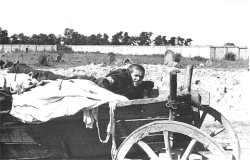 |
| A Siedlce Boy in his Hiding Place * |
"Not far from Gesi Borek was a glass works in which several tens of Jews worked. They lived in the vicinity of the works. Things were brought to them as well that had been smuggled out of the ghetto. During the last two days of the little ghetto’s functioning several carts of items were carried out. The Gestapo and gendarmes 'turned a blind eye', pretending that they did not see what the Jews were carrying out. Naïve people rejoiced that they had managed to trick the Germans. The last days before the move to the new ghetto several tens of people were moved to the glass works, including the old and sick people. They were hidden in a neighbouring barn." – wrote Ida Jom–Tow (Tenenbojm).
One of the apartment buildings of the ghetto had earlier been occupied by Gypsies. After three days, on 28 November 1942, the Nazis liquidated the ghetto. During the night they surrounded the area. The following morning they chased the people out of their homes, placed them in rows of five persons and drove them to the railway station, where the wagons were already waiting for them. A number of those marching were preparing themselves for death by donning prayer garments and adopting a resigned frame of mind. At the head of the procession walked the elderly Icchak Nachum Weintraub. People already knew what awaited them.
"In many wagons people began energetically to break the windows as soon as the train moved out. The well-known Siedlce master-locksmith Symcha Wilk had brought his tools with him, with which he could open the closed wagons. When the train was in full movement Wilk opened his wagon and a large number of condemned persons jumped out. Many also escaped from the wagon where the Jewish police were. However, a large number of people were shot on the spot or caught."
Samuel Willenberg, a prisoner of the Treblinka extermination camp, describes the arrival of this transport thus:
"Mitte (Miete) shouted for the cars top be opened. A child’s hand slid through a crack in the door. Suddenly we saw that all the cars were filled with corpses. The bodies of adults and children were mingled together, torn and entirely naked, one compact mass of human bodies with traces of beatings and holes from bullets."
Because people started to escape from the cattle cars, the whole transport was killed in transit. The same transport also contained many bodies of Romanies.
The work camps for Jews should also be mentioned. These camps were aimed at destroying the Jewish nation through hard physical labour. Within the environs of the town there were several camps in which only Jews worked.
Camp I – Army Food Storehouse No. 6 (A.V.L.)
This was formed at the beginning of 1940 and liquidated in 1942. It was located in the army barracks. The camp’s terrain covered around 5 square kilometres. The prisoners lived in a two story brick building on the grounds of the former barracks of the 22nd Foot Regiment. On average, around 100 persons worked there. In all, around 5,000 Jews passed through the camp. The prisoners worked on the camp’s grounds, loading wagons with food. During the liquidation of the camp, the prisoners were settled in the little ghetto.
Camp II – The Reckmann Construction Firm
The name came from the owner, Richard Reckmann. The camp was established in January 1941 and liquidated in March 1943. It was located in the fire-station and two barracks by the railway tracks. The camp occupied around 5 square kilometres. On average around 500 people were living there at any time. In all around 15,000 Jews passed through the camp. The prisoners worked for the Reckmann firm, building railway lines, working in the railway workshops and at construction sites. An epidemic of typhus and scarlet fever raged in the camp. There was a health clinic. For hard, inhumanely hard, work, the prisoners received 200 g of bread, 1/2 litre of black coffee, and 1 litre of soup consisting of chestnut flour, brukiew (very poor quality vegetables, used as cattle fodder) or beets. The Nazis shot many Jews, and many died as a result of being beaten. There were instances of burial alive at the construction site. The seriously ill were returned to the ghetto. The camp was intended to destroy the people working there, as is proven by the testimony of Srul Mejer, a prisoner of this camp:
"Litwak, a dentist from Siedlce, was shot because he walked too slowly to work by one of the Germans supervising us."
An eighty-year-old ritual butcher was beaten and trampled by the German guards because he could not manage to unload coal. The badly beaten man died soon after. During the liquidation of the work camp almost all the prisoners were shot. Three prisoners managed to survive; they were Srul Krawiec, Izaak Rafa (?), and Motl Orlanski. The barracks burned down during the struggle for the city in July 1944.
Camp III – German Building Inspectorate No. 8 "Kiesgrube"
This camp was established in 1941 and liquidated on 14 May 1943. It was located behind the Siedlce-Lukow railway line, by the Lukow road. It occupied a territory of around 2 square kilometres. On average around 300 people, who were housed in two wooden barracks and in railway wagons, were living there. The prisoners worked in gravel quarries, where the norm was the loading of around 150-200 wagons with sand a day. Food was 250 g of bread and 1 litre of soup. The director of the camp was Inspector Hoppe. There were cases of death by beating or during the loading work. During the liquidation of the camp some of the prisoners died in buildings that the Germans set on fire; the remainder were shot in the Jewish cemetery. Only Leon Kaplan survived.
Camp IV – the Wolfer and Göbel Road Construction Camp
This camp was established in 1941, and liquidated in October 1942. It was located on Brzeska Street. On average around 2,000 people were imprisoned there. The prisoners lived in 10 wooden barracks. The director was a certain Volksdeutscher named Wasilewski. In all around 20,000 Jews passed through the camp. The prisoners were engaged in road construction work for the Wolfer and Göbel firm, including work on the Brzesc and Siedlce to Warsaw roads and railway lines. This firm was working within the framework of the Organisation Todt. There was an epidemic of scarlet fever in the camp. During the liquidation of the camp the prisoners were moved to the little ghetto.
Camp V, the so-called "Bauzug"
This camp was located by the railway station. Around 100 prisoners lived in the camp, residing in railway cars. These prisoners worked repairing railway tracks on the Siedlce to Brzesc line. The director of the "Bauzug" was Walter, a railway man from Wuppertal.
Camp VI, the German Construction Inspectorate
This camp was located in barracks by the railway houses. It functioned from 1942 to 14 May 1943. 60 people, who were engaged in unloading building material, lived in it. The director of the camp was a German by the name of Schefner.
In addition to the camps mentioned above, a Jewish crew of around 30 persons worked on the grounds of the so-called "Agriculture Syndicate", around 60 worked in the Gesi Borek glass works, and around 100 at the army airport located in "New Siedlce".
The number of Jews who passed through the Jewish work camps should not be linked solely with the local Jews. Jews from the city’s environs, from little towns and villages, as well those moved to Siedlce from other places, also found themselves in the work camps.
In total 17,000 Jews died in the town or were transported to Treblinka. They came not only from Siedlce, but also from the ghettos in the Losice area (from Losice, Huszlewo, Olszanka, and Swiniarow), the Sarnaki area (from Sarnaki, Gorki, Kornica, Lysow), and the Mordy area (from Mordy, Krzesko-Krolow Niwa, Przesmyk, Stok Ruski, and Tarkow). Only a small number managed to hide, but they were in constant danger. The Siedlce dentist, Stanislaw Gilgun, who was hiding in Warsaw, perished during the Warsaw Uprising. Antoni and Stanislaw Górka were discovered and tortured to death in a Gestapo prison.
In 1943 the Germans tried to cover the traces of their crimes in Siedlce. With the help of a 40 person group of Jews from Bialystok they disinterred the bodies of the murdered and burned them in piles. For several days the stench of burning bodies hung over the town.
After the driving of the Germans from the town, a number of Jews who had survived returned to their homes. Within the territory of the Siedlce powiat there were barely 200 of them. The departing Jews went first to Lodz and then later left for Israel or other countries. After 1968 the children of those who had escaped extermination also left.
Trials:
DDR Case Nr.1035
Crime Category: War Crimes, Other Mass Extermination Crimes
Accused: Richter, Willi Life Sentence
Court: LG/BG Potsdam 740718
Country where the crime was committed: Poland
Crime Location: Siedlce, Sarnaki, Losice, unknown
Crime Date: 1940-43
Victims: Jews, Civilians, Prisoners of War
Nationality: Polish, Soviet
Office: Grenzpolizei Siedlce, Grenzpolizei Platerow (Frontier Police)
Subject of the proceeding: Arrest and mishandling of Polish civilians. Shooting "while trying to escape" of three Polish prisoners. Individual shootings of 6 Jews and Soviet prisoners of war. Participation in the mass shooting of 100 Soviet prisoners of war. Participation in the liquidation of the Siedlce, Sarnaki and Losice ghettos, part of whose inhabitants were shot on the spot while the others were deported to the Treblinka extermination camp. Shooting of a Jew who had gone in hiding after the clearing of the ghetto. Participation in the shooting of approximately 3,000 Jews at the Jewish cemetery in Siedlce as well as of 15 Jews of the remaining ghetto at Siedlce.
DDR Case Nr. 1038
Crime Category: War Crimes, Other Mass Extermination Crimes
Accused: Langer, Edmund Life Sentence
Court: LG/BG Potsdam 740228 Ob. Gericht der DDR 740419
Country where the crime was committed: Poland
Crime Location: Siedlce, Sarnaki, Losice
Crime Date: 1939-43
Victims: Jews, Civilians, Prisoners
Nationality: Polish
Office: Grenzpolizei (Frontier Police) Siedlce, Grenzpolizei Platerow
Subject of the proceeding: Individual shootings of altogether 10 Jews and Polish civilians. Participation in two mass shootings in the course of which 30 Jews and 80 Poles were killed. Participation in the deportation of an unidentified number of Jews from the Sarnaki and Siedlce ghettos to the Treblinka extermination camp. Mishandling of prisoners during interrogations.
Sources:
W. Grzymała, Wspomnienia, Memoirs, Białystok 1982-1985;
W. Sobczak, Cmentarz ..., s. 4; Dokumenty i materiały do dziej´w okupacji niemieckiej w Polsce, t.2 ; Akcje i "wysiedlenie", cz. I, opr. dr Józef Kernisz. Warszawa – Łodź – Kraków 1946. s. LXV IPN;
Archiwum Państwowe w Siedlcach (APS), Zbiór afiszy okupacyjnych powiatu siedleckiego, Collection of posters, State Archive in Siedlce;
Żydowski Instytut Historyczny w Warszawie, Zespół: Sądy Społeczne, Jewish Historical Institute – ŻIH, Sady Spoleczne collection;
E. Karpiński, Wspomnienia z okresu okupacji /w:/ Biuletyn Żydowskiego Instytutu Historycznego (ŻIH), nr 149 (1989); in: Jewish Historical Museum bulletin, etc.;
APS, Akta miasta Siedlce - Siedlce State Archive;
Księga pamięci Gminy Siedlce. Siedlce Memorial Book, Buenos Aires 1956;
T. Burstin-Berenstein, Deportacje i zagłada skupisk żydowskich w Dystrykcie Warszawskim, /w:/ Biuletyn ŻIH, nr 1/3(1952) in: Jewish Historical Museum bulletin, etc;
Wanda Więch – Tchórzewska, Żródła do dziejów okupacji hitlerowskiej na Podlasiu południowo – zachodnim /w:/ Podlasie w czasie II wojny światowej, Sources for history of hitlerite occupation of South-Western Poland, Siedlce 1997;
IPN, Ankieta Sądów Grodzkich (ASG), Institute of National Remembrance, Town courts survey;
N. Lasman, Pięćdziesiąt kilometrów od Treblinki, Fifty kilometers from Treblinka, Warszawa 1984;
S. Lewandowska, Ruch oporu na Podlasiu, Resistance movement in Podlasie region, Warszawa 1976;
A. K. Kunert (opr), "Żegota" Rada Pomocy Żydom 1942 – 1945, Zegota, 1942 – 1945, Warszawa 2002;
H. Piskunowicz, Siedlce w okresie okupacji hitlerowskiej w latach 1939 – 1944 /w:/ Społeczeństwo siedleckie w walce o wyzwolenie narodowe i społeczne, Siedlce under occupation, red. J. R. Szaflik. Warszawa 1991;
Rejestr miejsc i faktów zbrodni popełnionych przez okupanta hitlerowskiego na ziemiach polskich w latach 1939 – 1945. Województwo siedleckie, Index of Polish Martyrdom sites in Poland, Warszawa 1985;
Bogdan Osiński, Muzeum Walki i męczeństwa w Treblince. Relacja video, testimony (VHS), Museum in Treblinka collection;
IPN, Pamiętnik Cypory Jabłoń – Zonszajn ur. w 1915 r. i zamieszkałej w Siedlcach do 1942r., s. 1. Ksero odpisu maszynowego w posiadaniu autora. Pamiętnik ten został opublikowany przez Agatę Dąbrowską w "Szkicach Podlaskich" nr 9 (2000) Memoires of Cypora Jablon-Zonszajn in collection of Institute of National Remembrance;
M.T. Frankowski, J. Staszewski, Musimy Żydów zniszczyć, /w:/ article in "Tygodnik Siedlecki", nr 36 (1986);
Relacja Czesław Ulko, z dn. 2.01.1999 r. w posiadaniu autora, testimony, E. Kopowka collection;
Wywiad z Barbarą Górską nagrany techniką video w posiadaniu autora, testimony (VHS) E. Kopowka collection;
Encyclopedia of the Holocaust
R. Kuwalek
Justiz und NS-Verbrechen - http://www1.jur.uva.nl/junsv/index.htm
Map: GFH *
Photos:
GFH *
Yivo Institute *
USHMM *
ZIH Warszawa *
State Archives in Siedlce *
Source:
Sereny Gitta. Into That Darkness – From Mercy Killing To Mass Murder, Random House UK Limited, 1995
 |
| 18,000 Jews lived in the ghetto |
© ARC (http://www.deathcamps.org) 2005